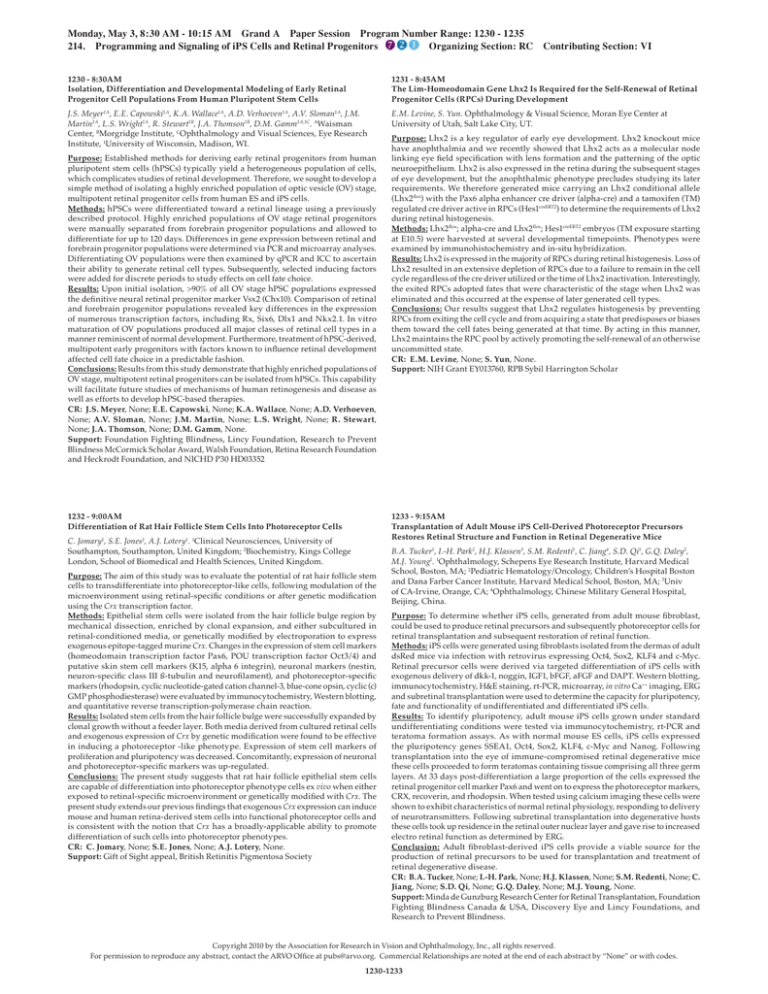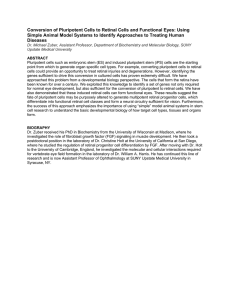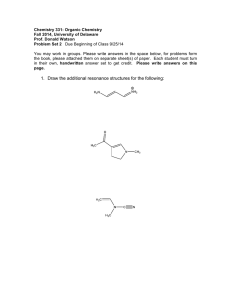
Monday, May 3, 8:30 AM - 10:15 AM Grand A Paper Session Program Number Range: 1230 - 1235
214. Programming and Signaling of iPS Cells and Retinal Progenitors
Organizing Section: RC Contributing Section: VI
1230 - 8:30AM
Isolation, Differentiation and Developmental Modeling of Early Retinal
Progenitor Cell Populations From Human Pluripotent Stem Cells
1231 - 8:45AM
The Lim-Homeodomain Gene Lhx2 Is Required for the Self-Renewal of Retinal
Progenitor Cells (RPCs) During Development
J.S. Meyer1A, E.E. Capowski1A, K.A. Wallace1A, A.D. Verhoeven1A, A.V. Sloman1A, J.M.
Martin1A, L.S. Wright1A, R. Stewart1B, J.A. Thomson1B, D.M. Gamm1A,1C. AWaisman
Center, BMorgridge Institute, COphthalmology and Visual Sciences, Eye Research
Institute, 1University of Wisconsin, Madison, WI.
E.M. Levine, S. Yun. Ophthalmology & Visual Science, Moran Eye Center at
University of Utah, Salt Lake City, UT.
Purpose: Established methods for deriving early retinal progenitors from human
pluripotent stem cells (hPSCs) typically yield a heterogeneous population of cells,
which complicates studies of retinal development. Therefore, we sought to develop a
simple method of isolating a highly enriched population of optic vesicle (OV) stage,
multipotent retinal progenitor cells from human ES and iPS cells.
Methods: hPSCs were differentiated toward a retinal lineage using a previously
described protocol. Highly enriched populations of OV stage retinal progenitors
were manually separated from forebrain progenitor populations and allowed to
differentiate for up to 120 days. Differences in gene expression between retinal and
forebrain progenitor populations were determined via PCR and microarray analyses.
Differentiating OV populations were then examined by qPCR and ICC to ascertain
their ability to generate retinal cell types. Subsequently, selected inducing factors
were added for discrete periods to study effects on cell fate choice.
Results: Upon initial isolation, >90% of all OV stage hPSC populations expressed
the definitive neural retinal progenitor marker Vsx2 (Chx10). Comparison of retinal
and forebrain progenitor populations revealed key differences in the expression
of numerous transcription factors, including Rx, Six6, Dlx1 and Nkx2.1. In vitro
maturation of OV populations produced all major classes of retinal cell types in a
manner reminiscent of normal development. Furthermore, treatment of hPSC-derived,
multipotent early progenitors with factors known to influence retinal development
affected cell fate choice in a predictable fashion.
Conclusions: Results from this study demonstrate that highly enriched populations of
OV stage, multipotent retinal progenitors can be isolated from hPSCs. This capability
will facilitate future studies of mechanisms of human retinogenesis and disease as
well as efforts to develop hPSC-based therapies.
CR: J.S. Meyer, None; E.E. Capowski, None; K.A. Wallace, None; A.D. Verhoeven,
None; A.V. Sloman, None; J.M. Martin, None; L.S. Wright, None; R. Stewart,
None; J.A. Thomson, None; D.M. Gamm, None.
Support: Foundation Fighting Blindness, Lincy Foundation, Research to Prevent
Blindness McCormick Scholar Award, Walsh Foundation, Retina Research Foundation
and Heckrodt Foundation, and NICHD P30 HD03352
1232 - 9:00AM
Differentiation of Rat Hair Follicle Stem Cells Into Photoreceptor Cells
Purpose: Lhx2 is a key regulator of early eye development. Lhx2 knockout mice
have anophthalmia and we recently showed that Lhx2 acts as a molecular node
linking eye field specification with lens formation and the patterning of the optic
neuroepithelium. Lhx2 is also expressed in the retina during the subsequent stages
of eye development, but the anophthalmic phenotype precludes studying its later
requirements. We therefore generated mice carrying an Lhx2 conditional allele
(Lhx2flox) with the Pax6 alpha enhancer cre driver (alpha-cre) and a tamoxifen (TM)
regulated cre driver active in RPCs (Hes1creERT2) to determine the requirements of Lhx2
during retinal histogenesis.
Methods: Lhx2flox; alpha-cre and Lhx2flox; Hes1creERT2 embryos (TM exposure starting
at E10.5) were harvested at several developmental timepoints. Phenotypes were
examined by immunohistochemistry and in-situ hybridization.
Results: Lhx2 is expressed in the majority of RPCs during retinal histogenesis. Loss of
Lhx2 resulted in an extensive depletion of RPCs due to a failure to remain in the cell
cycle regardless of the cre driver utilized or the time of Lhx2 inactivation. Interestingly,
the exited RPCs adopted fates that were characteristic of the stage when Lhx2 was
eliminated and this occurred at the expense of later generated cell types.
Conclusions: Our results suggest that Lhx2 regulates histogenesis by preventing
RPCs from exiting the cell cycle and from acquiring a state that predisposes or biases
them toward the cell fates being generated at that time. By acting in this manner,
Lhx2 maintains the RPC pool by actively promoting the self-renewal of an otherwise
uncommitted state.
CR: E.M. Levine, None; S. Yun, None.
Support: NIH Grant EY013760, RPB Sybil Harrington Scholar
1233 - 9:15AM
Transplantation of Adult Mouse iPS Cell-Derived Photoreceptor Precursors
Restores Retinal Structure and Function in Retinal Degenerative Mice
C. Jomary1, S.E. Jones2, A.J. Lotery1. 1Clinical Neurosciences, University of
Southampton, Southampton, United Kingdom; 2Biochemistry, Kings College
London, School of Biomedical and Health Sciences, United Kingdom.
Purpose: The aim of this study was to evaluate the potential of rat hair follicle stem
cells to transdifferentiate into photoreceptor-like cells, following modulation of the
microenvironment using retinal-specific conditions or after genetic modification
using the Crx transcription factor.
Methods: Epithelial stem cells were isolated from the hair follicle bulge region by
mechanical dissection, enriched by clonal expansion, and either subcultured in
retinal-conditioned media, or genetically modified by electroporation to express
exogenous epitope-tagged murine Crx. Changes in the expression of stem cell markers
(homeodomain transcription factor Pax6, POU transcription factor Oct3/4) and
putative skin stem cell markers (K15, alpha 6 integrin), neuronal markers (nestin,
neuron-specific class III ß-tubulin and neurofilament), and photoreceptor-specific
markers (rhodopsin, cyclic nucleotide-gated cation channel-3, blue-cone opsin, cyclic (c)
GMP phosphodiesterase) were evaluated by immunocytochemistry, Western blotting,
and quantitative reverse transcription-polymerase chain reaction.
Results: Isolated stem cells from the hair follicle bulge were successfully expanded by
clonal growth without a feeder layer. Both media derived from cultured retinal cells
and exogenous expression of Crx by genetic modification were found to be effective
in inducing a photoreceptor -like phenotype. Expression of stem cell markers of
proliferation and pluripotency was decreased. Concomitantly, expression of neuronal
and photoreceptor-specific markers was up-regulated.
Conclusions: The present study suggests that rat hair follicle epithelial stem cells
are capable of differentiation into photoreceptor phenotype cells ex vivo when either
exposed to retinal-specific microenvironment or genetically modified with Crx. The
present study extends our previous findings that exogenous Crx expression can induce
mouse and human retina-derived stem cells into functional photoreceptor cells and
is consistent with the notion that Crx has a broadly-applicable ability to promote
differentiation of such cells into photoreceptor phenotypes.
CR: C. Jomary, None; S.E. Jones, None; A.J. Lotery, None.
Support: Gift of Sight appeal, British Retinitis Pigmentosa Society
B.A. Tucker1, I.-H. Park 2, H.J. Klassen 3, S.M. Redenti1, C. Jiang4, S.D. Qi1, G.Q. Daley2,
M.J. Young1. 1Ophthalmology, Schepens Eye Research Institute, Harvard Medical
School, Boston, MA; 2Pediatric Hematology/Oncology, Children’s Hospital Boston
and Dana Farber Cancer Institute, Harvard Medical School, Boston, MA; 3Univ
of CA-Irvine, Orange, CA; 4Ophthalmology, Chinese Military General Hospital,
Beijing, China.
Purpose: To determine whether iPS cells, generated from adult mouse fibroblast,
could be used to produce retinal precursors and subsequently photoreceptor cells for
retinal transplantation and subsequent restoration of retinal function.
Methods: iPS cells were generated using fibroblasts isolated from the dermas of adult
dsRed mice via infection with retrovirus expressing Oct4, Sox2, KLF4 and c-Myc.
Retinal precursor cells were derived via targeted differentiation of iPS cells with
exogenous delivery of dkk-1, noggin, IGF1, bFGF, aFGF and DAPT. Western blotting,
immunocytochemistry, H&E staining, rt-PCR, microarray, in vitro Ca++ imaging, ERG
and subretinal transplantation were used to determine the capacity for pluripotency,
fate and functionality of undifferentiated and differentiated iPS cells.
Results: To identify pluripotency, adult mouse iPS cells grown under standard
undifferentiating conditions were tested via immunocytochemistry, rt-PCR and
teratoma formation assays. As with normal mouse ES cells, iPS cells expressed
the pluripotency genes SSEA1, Oct4, Sox2, KLF4, c-Myc and Nanog. Following
transplantation into the eye of immune-compromised retinal degenerative mice
these cells proceeded to form teratomas containing tissue comprising all three germ
layers. At 33 days post-differentiation a large proportion of the cells expressed the
retinal progenitor cell marker Pax6 and went on to express the photoreceptor markers,
CRX, recoverin, and rhodopsin. When tested using calcium imaging these cells were
shown to exhibit characteristics of normal retinal physiology, responding to delivery
of neurotransmitters. Following subretinal transplantation into degenerative hosts
these cells took up residence in the retinal outer nuclear layer and gave rise to increased
electro retinal function as determined by ERG.
Conclusion: Adult fibroblast-derived iPS cells provide a viable source for the
production of retinal precursors to be used for transplantation and treatment of
retinal degenerative disease.
CR: B.A. Tucker, None; I.-H. Park, None; H.J. Klassen, None; S.M. Redenti, None; C.
Jiang, None; S.D. Qi, None; G.Q. Daley, None; M.J. Young, None.
Support: Minda de Gunzburg Research Center for Retinal Transplantation, Foundation
Fighting Blindness Canada & USA, Discovery Eye and Lincy Foundations, and
Research to Prevent Blindness.
Copyright 2010 by the Association for Research in Vision and Ophthalmology, Inc., all rights reserved.
For permission to reproduce any abstract, contact the ARVO Office at pubs@arvo.org. Commercial Relationships are noted at the end of each abstract by “None” or with codes.
1230-1233
Monday, May 3, 8:30 AM - 10:15 AM Grand A Paper Session Program Number Range: 1230 - 1235
214. Programming and Signaling of iPS Cells and Retinal Progenitors
Organizing Section: RC Contributing Section: VI
1234 - 9:30AM
In vitro Induction of Retinitis Pigmentosa-Specific Photoreceptor Cells From
Patient-Derived Induced Pluripotent Stem Cells
1235 - 9:45AM
PAX6 and MITF Play a Dose-Dependent Role in Determining Cell Fate of the
Retinal Pigment Epithelium (RPE) and Putative Ocular Stem Cells
Z.-B. Jin, S. Okamoto, M. Takahashi. Laboratory for Retinal Regeneration, RIKEN
Center for Developmental Biology, Kobe, Japan.
K. Bharti1A, M. Gasper1A, M. Brucato1A, A. Maminishkis1B, S.S. Miller1B, H. Arnheiter1A.
A
NINDS, BNEI, 1National Institutes of Health, Bethesda, MD.
Purpose: Retinitis pigmentosa (RP) is a group of inherited retinal degeneration
characterized by night blindness and visual field defects which are caused by rod
photoreceptor death. Most causative genes are involved in phototransduction cascade
or signaling specifically in rod photoreceptor, and still are there some widely expressed
genes but their mutations only cause rod degeneration. The genetic heterogeneity
together with the inter-familiar and intra-familiar phenotypic variances in RP make
the disease research complex. It is thus attempted to investigate the phenotype of
individual photoreceptor cell with distinct genotype and its response to candidate
drugs. In this study, we aimed to generate patient-specific photoreceptor cells by
using an induced pluripotent stem (iPS) cells technology and an in vitro differentiation
strategy.
Methods: This study was approved by local ethical committee with informed consent
from patients. RP patients with different mutations/genes were studied. Fibroblast
cells were cultured from skin sample and were re-confirmed the genotype. The
fibroblasts were infected with retrovirus and/or non-integrating virus harboring four
reprogramming factors (OCT3/4, KLF4, c-MYC and SOX2). Established iPS cell lines
were amplified for in vitro differentiation. iPS cells were cultured under a serum-free
suspension conditions followed by an adherent culture. Immunocytochemistry and
gene expression profiling were performed to monitor the differentiation.
Results: Morphologically embryonic stem (ES) cell-like colonies were appeared after
infection of each type of virus. These cells were positive for pluripotent markers
(Nanog, Oct3/4, Tra-1-60, SSEA3). Furthermore, teratoma formation was confirmed by
all three-derm derivatives. Through in vitro differentiation, neural retinal progenitor
cells, retinal pigment epithelia (RPE) progenitor cells, RPE, and photoreceptor
precursor cells were induced sequentially. And rod photoreceptor cells emerged with
specific markers again rhodopsin and recoverin. Additionally, other types of retinal
cell, including cone, bipolar cells and ganglion cells, were also confirmed.
Conclusions: We successfully generated iPS cells from RP patients. These RP-derived
iPS cells do have differentiation potential into most retinal cells including the rod
photoreceptor cells which were lost in the patients. These induced patient-specific
rod photoreceptor cells may be useful for drug discovery, disease modeling, and
regenerative medicine.
CR: Z.-B. Jin, None; S. Okamoto, None; M. Takahashi, None.
Support: The Project for Realization of Regenerative Medicine from MEXT, Japan and
the RIKEN Foreign Postdoctoral Researcher program
Purpose: Previous observations in mice with mutations in the bHLH-zipper
transcription factor MITF suggested a potential role for increased levels of the paired/
homeodomain transcription factor PAX6 in regulating dorsal-restricted RPE-retina
transdifferentiation. Therefore, we evaluated the role of Pax6 gene dose in the RPE
and the ciliary epithelium (CE).
Methods: Histological and molecular evaluation of RPE-retina transdifferentiation
in mice harboring a combination of different Mitf and Pax6 alleles.
Results: A reduction of Pax6 gene dose in an Mitf mutant background markedly
enhances the hyperproliferation and dorsal-restricted RPE-retina transdifferentiation
observed with Mitf mutations alone. Conversely, an increase in Pax6 gene dose
decreases Mitf-mutation mediated hyperproliferation and transdifferentiation. This
regulation of RPE proliferation by Pax6 and Mitf is concomitant with an increase in
levels of alpha B crystallin which, based on studies in other cell types, decreases Cyclin
D1 protein stability through the ubiquitin ligase SCFFBX4 and so inhibits the cell cycle.
Moreover, PAX6 positively regulates TFEC, an MITF homolog, which, like MITF, is
thought to promote RPE development and inhibit retinogenic gene expression in the
RPE. In postnatal CE, high PAX6 levels expand a pool of putative stem cells while
low PAX6 levels, in conjunction with Mitf mutations, decrease this pool and increase
a pool of cells expressing retinal progenitor markers.
Conclusions: In the Mitf mutant RPE, a decrease in Pax6 gene dose leads to an increase
in retinal gene expression, and an increase in Pax6 gene dose to a decrease in retinal
gene expression. Consistent with this, in the postnatal CE, PAX6 levels regulate the
balance between putative stem cells and retinal progenitor cells. Thus, in both the
developing RPE and the postnatal CE, the coordinate reduction in PAX6 and MITF
activities helps to initiate the transition of cells towards a neuroretinal fate while an
increase in PAX6 and MITF/TFEC activities has antiretinogenic effects.
CR: K. Bharti, None; M. Gasper, None; M. Brucato, None; A. Maminishkis, None; S.S.
Miller, None; H. Arnheiter, None.
Support: NINDS
Copyright 2010 by the Association for Research in Vision and Ophthalmology, Inc., all rights reserved.
For permission to reproduce any abstract, contact the ARVO Office at pubs@arvo.org. Commercial Relationships are noted at the end of each abstract by “None” or with codes.
1234-1235




